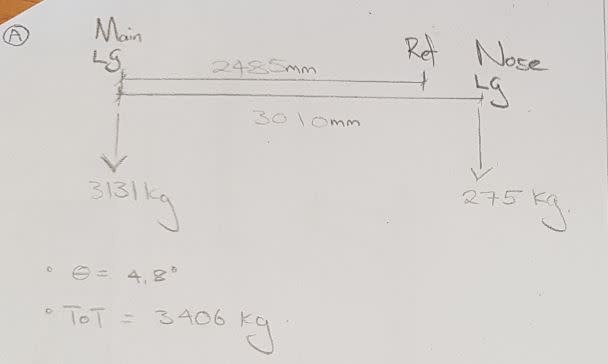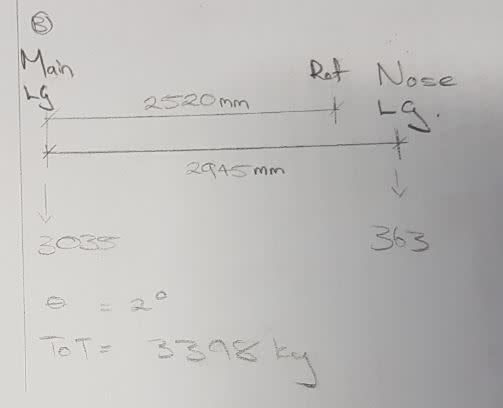Equestion
New member
- Jan 3, 2018
- 12
Good day all
I am struggling to get my head around this one![[ponder] [ponder] [ponder]](/data/assets/smilies/ponder.gif)
The situation is as follow;
If an aircraft is being weighed with 3 scales ( one at Each main Landing gear and one at the nose Landing gear) at a given and known angle for eg 4 degrees, is it possible to predict the GC at 0 Degrees?
I would like to know is there a way of applying maths as an iterative method to solve it?
A bit of background to why the question arose, I weighed an A/C getting the following readings:
In Situation A I got 3131 KG on the Main LG and 275Kg on the Nose LG, the angle was measured at 4.8 Degrees.
In Situation B I got 3035 KG on the Main LG and 363 Kg on the Nose LG, the angle was measured at 2 Degrees. Situation B was created by deflating the Nose LG strut slightly. See pics below to illustrate situation A and B better.


I am struggling to get my head around this one
![[ponder] [ponder] [ponder]](/data/assets/smilies/ponder.gif)
The situation is as follow;
If an aircraft is being weighed with 3 scales ( one at Each main Landing gear and one at the nose Landing gear) at a given and known angle for eg 4 degrees, is it possible to predict the GC at 0 Degrees?
I would like to know is there a way of applying maths as an iterative method to solve it?
A bit of background to why the question arose, I weighed an A/C getting the following readings:
In Situation A I got 3131 KG on the Main LG and 275Kg on the Nose LG, the angle was measured at 4.8 Degrees.
In Situation B I got 3035 KG on the Main LG and 363 Kg on the Nose LG, the angle was measured at 2 Degrees. Situation B was created by deflating the Nose LG strut slightly. See pics below to illustrate situation A and B better.


